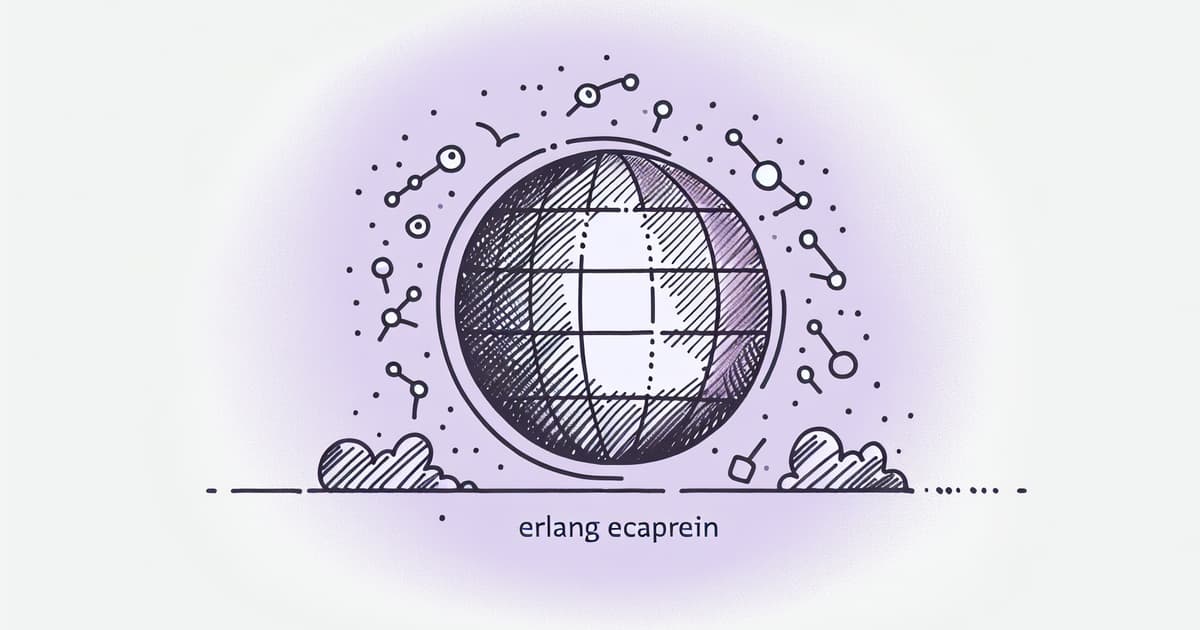We can't find the internet
Attempting to reconnect
Something went wrong!
Hang in there while we get back on track
BEAM

The underlying technology of Erlang and BEAM is pivotal in various realms of modern software engineering, from networking and web development to machine learning and security. Contributing to the richness of the BEAM ecosystem, Erlang OTP team members discuss the intricacies of the language and libraries that power scalable, fault-tolerant applications. Parallelly, discussions within the Elixir community, particularly through Beam Radio, highlight Elixir's functional programming elegance, its concurrency models, and tools like Phoenix LiveView that are revolutionizing web development.
Elixir's capabilities are empowering developers to build complex, efficient systems with ease. The application of BEAM technologies spans across industries, with particular note in the fields of machine learning, where libraries like Nx and FLAME are posited as formidable alternatives in elastic workloads. In financial services, Erlang and Elixir's real-time processing and fault tolerance are underlined as key enablers.
Contributors enthusiastically share their experiences, ranging from Ash Framework's proponents elucidating its advantages for Elixir development to the exploration of security in Elixir coding practices and the use of tools safeguarding the codebase. Security experts discuss crucial aspects such as code security prioritization and elucidate on practices that strengthen application defenses within the ecosystem. The community also delves into the deployment of Elixir applications on a global scale, where developers leverage platforms like Fly.io to distribute applications across the world with minimal logistics.
Observability features unique to the BEAM runtime are discussed, paired with insights into networking solutions that benefit from BEAM's robust architecture for handling connections and building resilient systems. The BEAM community celebrates its continuous adaptation and integration of cutting-edge solutions like the Nerves Project for embedded systems and the utilization of pattern-matching for high-performance text and name search features in databases like Postgres, often as replacements for technologies like Elasticsearch.
The Elixir community is vibrant with ongoing discourse about state handling, concurrency, distributed systems, and the BEAM's potential beyond its current applications. Dynamic discussions at conferences, such as ElixirConf, delve into topics like asset portfolio optimization and real-time product development, highlighting the BEAM's versatility. Learning and knowledge sharing are cornerstones of the community, with engagements ranging from hosting informative episodes on dependency management to utilizing frameworks that integrate effortlessly with Elixir, among other best practices.

Elixir Apprenticeships - Beam Radio Episode 43
Andrew Ek and Chris Nelson discuss the benefits and patterns of Elixir apprenticeships on Beam Radio.

Beam Radio discusses Membrane with lead architect Mateusz Front
Mateusz Front, a lead architect at Membrane, talks with the Beam Radio panel about the innovative work happening with BEAM technologies at Membrane.

ElixirConf 2023 Behind the Scenes Insights
This episode of Beam Radio provides listeners with exclusive behind-the-scenes interviews from ElixirConf 2023, featuring conversations with several key community members.

Preview of Elixir Conference Episode
This episode of Beam Radio delves into what to expect at the upcoming Elixir Conf. It features discussions and insights from various hosts involved in the Elixir community, as well as information about their sponsors, Groxio and Underjord.

Transitioning from Ruby to Elixir Discussion with Steve Bussey
Steve Bussey discusses language adoption and the transition from Ruby to Elixir on BeamRadio.

Reflecting on Chris McCord's LiveView Keynote with the BeamRadio Team
The BeamRadio team discusses Chris McCord's keynote on LiveView from ElixirConf 2022 and offers a discount code for CodeBeam tickets.

Discussion of Elixir Projects and Community Engagement
This episode of Beam Radio features a conversation with hosts Steven and Lars, including discussions about Elixir projects and how to engage with the community.

Beam Radio Podcast: Bruce's Adventures and Elixir Resources
This episode features various resources and announcements for Elixir developers, including a mention of the upcoming GigCityElixir conference.

Discussion on Nerves with Alex McLain
The BeamRadio panel converses with Alex McLain about Nerves and learning in the context of the BEAM ecosystem.

Discussion on Nerves and Puppeteering with Flora Petterson
Flora Petterson, technical writer and puppeteer, shares her experience on using the Nerves project platform for animating puppets.

Discussion on Creating Well-Functioning Elixir Teams
Meryl Dakin discusses the process of building and nurturing healthy teams for Elixir development, sharing insights from her experience.

Interview with José Valim on Beam Radio
José Valim talks to Beam Radio about Elixir, and the show welcomes new host Meryl Dakin.

Exploring Elixir's Unique Features with Dave Lucia
Dave Lucia discusses the distinctive capabilities of Elixir and the vibrancy of its community.

Discussion with Paul Dawson on Genserver.social and GigCityElixir
Paul Dawson discusses his work on Genserver.Social in an engaging conversation with the Beam Radio team.

Discussing Elixir Security with Michael Lubas on Beam Radio
In this episode of Beam Radio, the panel engages with Paraxial founder Michael Lubas to delve into security aspects of the Elixir programming language.

Discussing the Nerves Project in Elixir with Frank Hunleth
Frank Hunleth discusses his experiences with the Nerves Project and its applications in Elixir.

Building CLI Applications with Elixir – A Comprehensive Guide
Brewing Elixir provides an overview of command-line interface (CLI) applications and the options for building them in Elixir.

Simplifying BEAM Clustering for Global Distribution
Jason Stiebs explores the advantages of running Elixir and Phoenix applications globally with minimal setup using Fly.io's integrated WireGuard networking for Erlang distribution and clustering.

Understanding Code Shepherding in Elixir
Amos King delivers a talk on 'The Importance of Shepherding' at GigCityElixir 2023. He emphasizes the value of shepherding in software development.

Improving Healthcare Outcomes with Elixir's Actor Model
Bryan Hunter discusses HCA's Waterpark, a powerful distributed system built with Elixir, focusing on its development and significant impact on healthcare.

Introduction to the Erlang Ecosystem Foundation
Desmond Bowe discusses the inception and goals of the Erlang Ecosystem Foundation.

Understanding Process Potential for Concurrency and Fault Tolerance in Elixir
Meryl Dakin discusses the power of OTP in Elixir for enabling multitasking and fault tolerance within applications. She presents a practical example of an app that deploys lessons to Github repositories to showcase how OTP's concurrency tools can help developers efficiently manage tasks, maintain global state, and ensure reliability, even for those transitioning from object-oriented programming backgrounds.

Introduction to the Erlang Ecosystem Foundation by Peer Stritzinger
Peer Stritzinger discusses the Erlang Ecosystem Foundation, outlining its mission and key objectives, including coordination of languages on the BEAM, support for open-source initiatives, and collaboration outside of Ericsson.

Elixir's process management and the $callers and $ancestors features
Isaac Yonemoto discusses Elixir's secret features $callers and $ancestors and their role in process management.

Introducing Burrito: A Mix Release Tool for Cross-Platform Elixir Application Deployment
Digit, a senior firmware engineer, introduced Burrito, a mix release tool for building cross-platform single file binaries for Elixir applications with no requirement for Erlang on the target machine. It simplifies the deployment process, eliminates the need for cross toolchains, and is highly extensible.

Switching from Cassandra to SQLite in Elixir for High Volume Data Processing
Jace Warren, a Principal Software Engineer at Savi Solutions, details the transition from using Cassandra to SQLite for managing video surveillance data. This change in database technology was necessary due to performance degradation and increasing costs with their Cassandra cluster as the company handles over a billion records per day. By leveraging Elixir, SQLite, and the Beam, they distributed storage workloads across application servers, significantly reducing overhead and costs.

Understanding Networking on the BEAM with Elixir
Andrea Leopardi presents insights into how the BEAM's architecture is particularly suited for network applications. He discusses the handling of TCP connections and the design patterns for building scalable and fault-tolerant systems.

Understanding Elixir Debugging Tools Based on Erlang Fundamentals
Lorena Mireles discusses Elixir's powerful debugging tools, which leverage Erlang's capabilities to manage complex systems and streamline troubleshooting processes.

Exploring Elixir Supervision Strategies via Doom
André Albuquerque presents a creative take on Elixir supervision strategies by running simulations in the game Doom.

Elixir's Impact on Machine Learning and Production Workflows
Christopher Grainger explores the integration of machine learning in production within the Elixir ecosystem, highlighting the use of Nx, Livebook, and Scholar.

Exploring Concurrency in Elixir with The Actor Model
Lars Wikman provides an in-depth look at The Actor Model as it pertains to Elixir and the underlying BEAM VM, debunking the terminology's use in Elixir while covering processes, message passing, GenServers, and architectural patterns.

Discussion on OpenID Connect with Jonatan Männchen
Jonatan Männchen leads technology at Sustema and is a member of ErlEF's security working group. He is featured in this episode to discuss the power of OpenID Connect on the BEAM.

Discovering the Hidden Value of Elixir Beyond Functional Programming
Owen Bickford discusses why Elixir is his preferred programming language, highlighting its functional paradigm, concurrency, and fault tolerance. He also delves into a lesser talked about feature of Elixir that allows it to solve problems previously considered unfit for the language and the BEAM.

Discussion with Jenny Bramble on Testing in Software Development
Jenny Bramble joins the panel to discuss testers and developers and shares insights on making code better. Check out Jenny's ElixirConf 2023 talk: Black Box Techniques for Unit Tests.

Methods of State Management in Elixir and BEAM
Isaac Yonemoto presents 11 different ways to store state in the BEAM VM, discussing the dangers of shared state in distributed and concurrent systems. This talk is aimed at both beginners and experienced developers, providing examples and insights to help programmers avoid potential pitfalls.

The Comprehensive Capabilities of Elixir and Phoenix
Jason Stiebs explains why Elixir and Phoenix are an excellent choice for developers, highlighting the various features and advantages of the language and framework. Learn about the built-in support for concurrency, distribution, RPC, low resource usage, and more!

Automated Telemetry for Elixir Production Environments
Chris Bailey discusses the work that his team at Vetspire has done to automate the process of bootstrapping an easy, ergonomic Telemetry solution for Elixir production apps, making good metrics/traces/telemetry less manual, repetitive, and error-prone.

Understanding Web Application Security in Elixir with Sobelow
Michael Lubas delves into the tricky world of cybersecurity, discussing the 23andMe data breach and the informative guide on web application security best practices for BEAM languages. He also explores the practical application of Sobelow, a security-focused static code analysis tool, using Paraxial.io's vulnerable-by-design 'Potion Shop' app as a case study.

An Overview of http_cache for BEAM
Introducing http_cache, a BEAM-native standard-compliant HTTP caching library. Tangui explains the motivation and features behind the Erlang library along with 2 Elixir libraries that make use of it.

Enhancing Elixir Performance using NIFs
Andres C Alejos discusses the power of Native Implemented Functions (NIFs) in Elixir and shares tips for working with them. He also provides real-world examples of using NIFs and showcases the EXGBoost library.

Exploring Elixir's Unique Observability Features
Lars Wikman shares insights on the observability features unique to the BEAM runtime and how Elixir has excellent tools for monitoring and debugging applications.

Deep Dive into LiveView Processes in Elixir
Jason Stiebs delves into the process aspect of LiveView in his talk at ElixirConf 2023, exploring the implications and demonstrating how to spy on an active LiveView.

Developing AI Applications Using Elixir
Charlie Holtz discusses prototyping and deploying AI agents with Elixir, highlighting the benefits of using the BEAM + Elixir Agents for building specialized AI models and applications in a distributed, functional, and scalable manner.

Creating and Managing Distributed Elixir Tasks on Fly.io
Jason Stiebs shows how to use Elixir and Fly.io to start a Machine anywhere in the world, execute code on it, and communicate with it as if it was running locally. The post explains how to achieve global distribution and highlights the benefits of using Elixir with a distributed global network.

Discussion and Insights on Elixir Development
Adi, Allen, and Sascha dive deep into observability and tracing in the Beam, discussing the advantages of using open telemetry and exploring different levels of observability, from Phoenix Live View to telemetry and tracing operations in large pipelines.

Integrating Prometheus Metrics and Grafana Dashboards with Elixir using PromEx
Alexandre Moreira Xavier shows you how to build your own Prometheus metrics using PromEx. PromEx is a library made by Alexander Koutmos that helps you integrate your Elixir application with Prometheus and Grafana.

ElixirConf 2023 Behind the Scenes Episode 59
Beam Radio presents the final ElixirConf bonus episode featuring interviews with speakers and attendees, including Greg Vaughn, Jenny Bramble, Desmond Bowe, José Valim, Ryan Schneck, Razvan Draghici, Sam McDavid, and more.

Understanding Elixir's Low Latency Capabilities
Lars explores how Elixir leverages Erlang's soft real-time capability and consistently low latency to provide a near-realtime experience and enhance user satisfaction.

Managing Large Files in Elixir Applications
Claudio Ortolina discusses the challenges of handling large files in Elixir and provides recommendations and strategies to mitigate memory-related issues. The post also includes three use cases, along with measurements and approaches for each case, offering a methodical approach for working with large files in similar situations.

Asynchronous Task Management in Phoenix LiveView
In this blog post, Mark Ericksen explains how to build an asynchronous workflow in a LiveView using Elixir's concurrency primitives. He demonstrates how to link processes, trap exits, and handle tasks, providing a step-by-step guide to achieve an elegant and efficient solution.
© HashMerge 2026